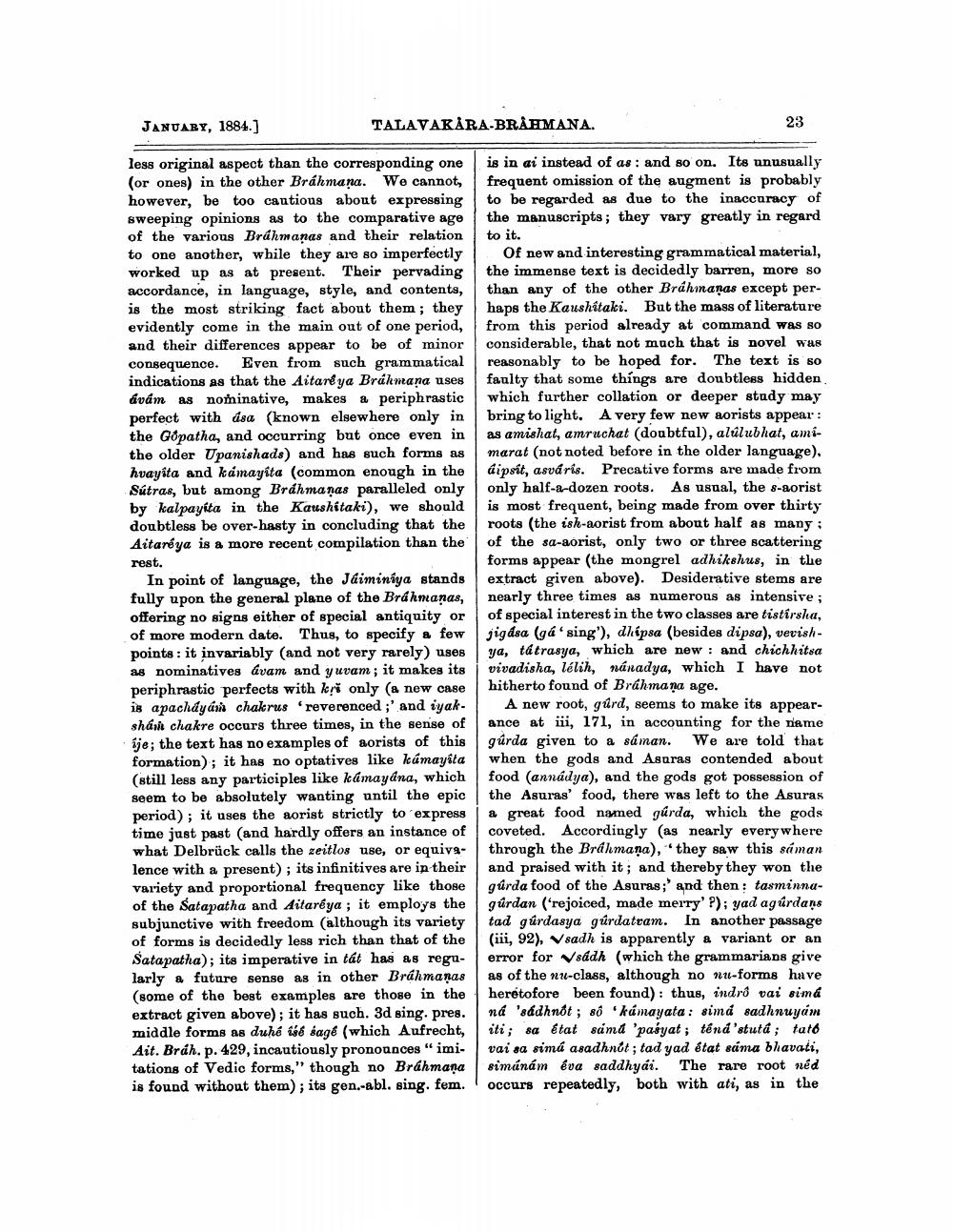________________
JANUARY, 1884.]
TALAVARÅRA-BRAHMANA.
23
less original aspect than the corresponding one is in ai instead of as : and so on. Its unusually (or ones) in the other Brahmana. We cannot, frequent omission of the augment is probably however, be too cautious about expressing to be regarded as due to the inaccuracy of sweeping opinions as to the comparative age the manuscripts; they vary greatly in regard of the various Brahmanas and their relation to it. to one another, while they are so imperfectly 1 Of new and interesting grammatical material, worked up as at present. Their pervading the immense text is decidedly barren, more so accordance, in language, style, and contents, than any of the other Brahmanas except peris the most striking fact about them; they haps the Kaushitaki. But the mass of literature evidently come in the main out of one period, from this period already at command was so and their differences appear to be of minor considerable, that not much that is novel was consequence. Even from such grammatical reasonably to be hoped for. The text is so indications as that the Aitareya Brákmana uses faulty that some things are doubtless hidden ávám as nominative, makes a periphrastic which further collation or deeper study may perfect with dsa (known elsewhere only in bring to light. A very few new aorists appear : the Gopatha, and occurring but once even in as amishat, amruchat (doubtful), alúlubhat, amithe older Upanishads) and has such forms as marat (not noted before in the older language), hvayita and kámayita (common enough in the dipsit, asváris. Precative forms are made from Sútras, but among Brahmanas paralleled only only half-a-dozen roots. As usual, the s-aorist by kalpayita in the Kaushitaki), we should is most frequent, being made from over thirty doubtless be over-hasty in concluding that the roots (the ish-aorist from about half as many : Aitaré ya is a more recent compilation than the of the sa-aorist, only two or three scattering rest.
forms appear (the mongrel adhikshus, in the In point of language, the Jaiminiya stands extract given above). Desiderative stems are fully upon the general plane of the Brahmanas, nearly three times as numerous as intensive; offering no signs either of special antiquity or of special interest in the two classes are tistirsha, of more modern date. Thus, to specify a few jigdsa (gá' sing'), dhipsa (besides dipsa), verishpoints: it invariably (and not very rarely) uses ya, tá trasya, which are new : and chichhitsa as nominatives avam and yuvam; it makes its vivadisha, lélih, nánadya, which I have not periphrastic perfects with keri only (a new case hitherto found of Brahmana age. is apacháyási chakrus reverenced ;' and iyak- A new root, gård, seems to make its appearsháni chakre occurs three times, in the sense of ance at iii, 171, in accounting for the name ije; the text has no examples of aorists of this gúrda given to a sá man. We are told that formation); it has no optatives like kúmayita when the gods and Asuras contended about (still less any participles like kamaydna, which food (annádya), and the gods got possession of seem to be absolutely wanting until the epic the Asuras' food, there was left to the Asuras period); it uses the aorist strictly to express a great food named gárda, which the gods time just past (and hardly offers an instance of coveted. Accordingly (as nearly everywhere what Delbrück calls the zeitlos use, or equiva- through the Brahmana), 'they saw this saman lence with a present); its infinitives are in their and praised with it; and thereby they won the variety and proportional frequency like those | gúrda food of the Asuras;' and then: tasminnaof the Satapatha and Aitaréya; it employs the gúrdan (“rejoiced, made merry'?); yad agúrdans
unctive with freedom (although its variety tad gúrdasya gúrdatram. In another passage of forms is decidedly less rich than that of the (iii, 92), Vsadh is apparently a variant or an Satapatha); ita imperative in tát has as regu- error for Vsádh (which the grammarians give larly a future sense as in other Brahmanas as of the nu-class, although no nu-forms have (some of the best examples are those in the heretofore been found): thus, indrs vai sima extract given above); it has such. 3d sing. pres. na 'sádhnốt; 88 kámayata : simd sadhnuyam middle forms as duhé ise sage (which Aufrecht, iti; sa état samd 'paśyat; tênd'stutá ; tato Ait. Bráh. p. 429, incautiously pronounces “imi- | vai sa simá asadhnót; tad yad état sama bhavati, tations of Vedic forms," though no Brahmana simánám eva saddhyái. The rare root ned is found without them); its gen.-abl. sing. fem. occurs repeatedly, both with ati, as in the




